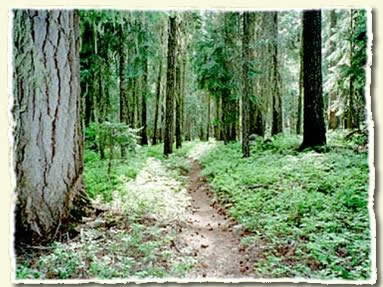Pacific Crest Trail - Grand Meadows, Big Mosquito Lake, Surprise Lake, WA
Approximately 15 Miles rt - rolling terrain - maximum elevation 4,600 ft

Zigzagging its way from Mexico to Canada through California, Oregon and Washington the Pacific Crest Trail (PCT) boasts the greatest elevation changes of any of America's National Scenic Trails, allowing it to pass through six out of seven of North America's ecozones including high and low desert, old-growth forest and artic-alpine country. Indeed, the PCT is a trail of diversity and extremes. From scorching desert valleys in Southern California to rain forests in the Pacific Northwest, the PCT offers hikers and equestrians a unique, varied experience.
Located within driving distance of San Diego, Los Angeles, San Francisco, Sacramento, Portland, and Seattle, the PCT is both easily accessible and blissfully wild at the same time. Whether you'd like to explore the PCT for weeks on end, or just a weekend, it offers the best of the West - the Mojave Desert, the Sierra Nevada and Mt. Whitney, Yosemite National Park, Marble Mountain and the Russian Wilderness in Northern California, the volcanoes of the Cascades including Mt. Shasta and Mt. Hood, Crater Lake, Columbia River Gorge, Mt. Rainier, and the remote Northern Cascades.
Over the past decade the PCT has become a favorite target of thru-hikers and thru-riders (the hearty souls who attempt to hike or ride an entire long-distance trail in one "season"). Each year, in fact, an average of 300 hikers attempt to cover the full length of the PCT (thru-riders are more rare but increasing in number). Thousands of other hikers and equestrians enjoy this national treasure each year, some traveling only a few miles in the course of a day hike.
Whether you visit the PCT for a few hours or for a few weeks you'll surely find a uniquely Western scene that will rejuvenate, inspire and surprise you. Two thousand six hundred and fifty miles of adventure and discovery are waiting.
Washington
Home to the spectacular Northern Cascades, the Washington section of the PCT rivals that of Central California and the Sierra Nevada in terms of dramatic, mountainous scenery. The Washington PCT also boasts some of the trail's most fickle weather patterns, especially in September when most thru-hikers and riders enter the state. Some years, September in this northernmost PCT state is bright and sunny, others it's cold and rainy - be prepared.
The section begins at the Bridge of the Gods (elev.180'), on the Columbia River, and ends at Monument 78 on the Canadian border (elev. 4,240'). An additional seven miles was added beyond the border by the Canadian government to provide access to Highway 3 in British Columbia's Manning Provincial Park (elev. 3,800').
The Washington PCT starts with a lengthy climb out of the Columbia River gorge and into the Indian Heaven Wilderness, a lake-blessed land abounding with huckleberries. Next, the trail rounds Mt. Adams (elev. 12,276') and heads into the rugged Goat Rocks Wilderness (where scenery is similar to that of the High Sierra) to traverse the Packwood Glacier.
The PCT crosses Highway 12 at White Pass encountering dozens of lakes in the William O. Douglas Wilderness. Between White Pass and Highway 410 at Chinook Pass, the trail skirts many more lakes as it approaches the towering monarch of the Cascades, Mt. Rainier (elev. 14,410').
From Chinook Pass the trail has an easy, rapid run to Interstate 90 at Snoqualmie Pass, which is fortunate, since this stretch traverses numerous clear-cuts that offer little cover from often-present rain.
Entering the North Cascades, the PCT climbs up a deep canyon to a pass, only to descend another deep canyon and then repeat the cycle again. It traverses popular Alpine Lakes, Henry M. Jackson, and Glacier Peak Wildernesses before crossing the Lake Chelan National Recreation Area, North Cascades National Park, and Pasayten Wilderness. The prime attraction here is Glacier Peak and the North Cascades' 750 perennial snowfields and small glaciers, which collectively account for about half the snowfield area in the lower 48 states.
Visiting Washington in September, hikers and riders are treated to the bright yellow needles of western larch and the crimson hues of huckleberry bushes -- a colorful conclusion to any PCT journey.

